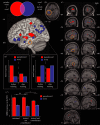A complementary systems account of word learning: neural and behavioural evidence
- PMID: 19933145
- PMCID: PMC2846311
- DOI: 10.1098/rstb.2009.0111
A complementary systems account of word learning: neural and behavioural evidence
Abstract
In this paper we present a novel theory of the cognitive and neural processes by which adults learn new spoken words. This proposal builds on neurocomputational accounts of lexical processing and spoken word recognition and complementary learning systems (CLS) models of memory. We review evidence from behavioural studies of word learning that, consistent with the CLS account, show two stages of lexical acquisition: rapid initial familiarization followed by slow lexical consolidation. These stages map broadly onto two systems involved in different aspects of word learning: (i) rapid, initial acquisition supported by medial temporal and hippocampal learning, (ii) slower neocortical learning achieved by offline consolidation of previously acquired information. We review behavioural and neuroscientific evidence consistent with this account, including a meta-analysis of PET and functional Magnetic Resonance Imaging (fMRI) studies that contrast responses to spoken words and pseudowords. From this meta-analysis we derive predictions for the location and direction of cortical response changes following familiarization with pseudowords. This allows us to assess evidence for learning-induced changes that convert pseudoword responses into real word responses. Results provide unique support for the CLS account since hippocampal responses change during initial learning, whereas cortical responses to pseudowords only become word-like if overnight consolidation follows initial learning.
Figures



References
-
- Allopenna P. D., Magnuson J. S., Tanenhaus M. K.1998Tracking the time course of spoken word recognition using eye movements: evidence for continuous mapping models. J. Memory Lang. 38, 419–439 (doi:10.1006/jmla.1997.2558) - DOI
-
- Altmann G. T., Kamide Y.1999Incremental interpretation at verbs: restricting the domain of subsequent reference. Cognition 73, 247–264 (doi:10.1016/S0010-0277(99)00059-1) - DOI - PubMed
-
- Atallah H. E., Rudy J. W., O'Reilly R. C.2008The role of the dorsal striatum and dorsal hippocampus in probabilistic and deterministic odor discrimination tasks. Learn Memb. 15, 294–298 (doi:10.1101/lm.754208) - DOI - PMC - PubMed
-
- Baddeley A., Gathercole S., Papagno C.1998The phonological loop as a language learning device. Psychol. Rev. 105, 158–173 (doi:10.1037/0033-295X.105.1.158) - DOI - PubMed
-
- Barnes J. M., Underwood B. J.1959Fate of first-list associations in transfer theory. J. Exp. Psychol. 58, 97–105 (doi:10.1037/h0047507) - DOI - PubMed
Publication types
MeSH terms
Grants and funding
LinkOut - more resources
Full Text Sources
Medical

